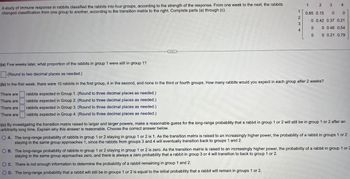
MATLAB: An Introduction with Applications
6th Edition
ISBN: 9781119256830
Author: Amos Gilat
Publisher: John Wiley & Sons Inc
expand_more
expand_more
format_list_bulleted
Question
None

Transcribed Image Text:A study of immune response in rabbits classified the rabbits into four groups, according to the strength of the response. From one week to the next, the rabbits
changed classification from one group to another, according to the transition matrix to the right. Complete parts (a) through (c).
1
2
3
4
0.85 0.15
0 0
2
3
4
ooo
0 0.42 0.37 0.21
0 0.46 0.54
0
0 0.21 0.79
(a) Five weeks later, what proportion of the rabbits in group 1 were still in group 1?
(Round to two decimal places as needed.)
(b) In the first week, there were 10 rabbits in the first group, 4 in the second, and none in the third or fourth groups. How many rabbits would you expect in each group after 2 weeks?
There are
There are
There are
There are
rabbits expected in Group 1. (Round to three decimal places as needed.)
rabbits expected in Group 2. (Round to three decimal places as needed.)
rabbits expected in Group 3. (Round to three decimal places as needed.)
rabbits expected in Group 4. (Round to three decimal places as needed.)
(c) By investigating the transition matrix raised to larger and larger powers, make a reasonable guess for the long-range probability that a rabbit in group 1 or 2 will still be in group 1 or 2 after an
arbitrarily long time. Explain why this answer is reasonable. Choose the correct answer below.
OA. The long-range probability of rabbits in group 1 or 2 staying in group 1 or 2 is 1. As the transition matrix is raised to an increasingly higher power, the probability of a rabbit in groups 1 or 2
staying in the same group approaches 1, since the rabbits from groups 3 and 4 will eventually transition back to groups 1 and 2.
OB. The long-range probability of rabbits in group 1 or 2 staying in group 1 or 2 is zero. As the transition matrix is raised to an increasingly higher power, the probability of a rabbit in group 1 or 2
staying in the same group approaches zero, and there is always a zero probability that a rabbit in group 3 or 4 will transition to back to group 1 or 2.
OC. There is not enough information to determine the probability of a rabbit remaining in group 1 and 2.
OD. The long-range probability that a rabbit will still be in groups 1 or 2 is equal to the initial probability that a rabbit will remain in groups 1 or 2.
Expert Solution
This question has been solved!
Explore an expertly crafted, step-by-step solution for a thorough understanding of key concepts.
Step by stepSolved in 2 steps

Knowledge Booster
Similar questions
Recommended textbooks for you
 MATLAB: An Introduction with ApplicationsStatisticsISBN:9781119256830Author:Amos GilatPublisher:John Wiley & Sons Inc
MATLAB: An Introduction with ApplicationsStatisticsISBN:9781119256830Author:Amos GilatPublisher:John Wiley & Sons Inc Probability and Statistics for Engineering and th...StatisticsISBN:9781305251809Author:Jay L. DevorePublisher:Cengage Learning
Probability and Statistics for Engineering and th...StatisticsISBN:9781305251809Author:Jay L. DevorePublisher:Cengage Learning Statistics for The Behavioral Sciences (MindTap C...StatisticsISBN:9781305504912Author:Frederick J Gravetter, Larry B. WallnauPublisher:Cengage Learning
Statistics for The Behavioral Sciences (MindTap C...StatisticsISBN:9781305504912Author:Frederick J Gravetter, Larry B. WallnauPublisher:Cengage Learning Elementary Statistics: Picturing the World (7th E...StatisticsISBN:9780134683416Author:Ron Larson, Betsy FarberPublisher:PEARSON
Elementary Statistics: Picturing the World (7th E...StatisticsISBN:9780134683416Author:Ron Larson, Betsy FarberPublisher:PEARSON The Basic Practice of StatisticsStatisticsISBN:9781319042578Author:David S. Moore, William I. Notz, Michael A. FlignerPublisher:W. H. Freeman
The Basic Practice of StatisticsStatisticsISBN:9781319042578Author:David S. Moore, William I. Notz, Michael A. FlignerPublisher:W. H. Freeman Introduction to the Practice of StatisticsStatisticsISBN:9781319013387Author:David S. Moore, George P. McCabe, Bruce A. CraigPublisher:W. H. Freeman
Introduction to the Practice of StatisticsStatisticsISBN:9781319013387Author:David S. Moore, George P. McCabe, Bruce A. CraigPublisher:W. H. Freeman

MATLAB: An Introduction with Applications
Statistics
ISBN:9781119256830
Author:Amos Gilat
Publisher:John Wiley & Sons Inc

Probability and Statistics for Engineering and th...
Statistics
ISBN:9781305251809
Author:Jay L. Devore
Publisher:Cengage Learning

Statistics for The Behavioral Sciences (MindTap C...
Statistics
ISBN:9781305504912
Author:Frederick J Gravetter, Larry B. Wallnau
Publisher:Cengage Learning

Elementary Statistics: Picturing the World (7th E...
Statistics
ISBN:9780134683416
Author:Ron Larson, Betsy Farber
Publisher:PEARSON

The Basic Practice of Statistics
Statistics
ISBN:9781319042578
Author:David S. Moore, William I. Notz, Michael A. Fligner
Publisher:W. H. Freeman

Introduction to the Practice of Statistics
Statistics
ISBN:9781319013387
Author:David S. Moore, George P. McCabe, Bruce A. Craig
Publisher:W. H. Freeman